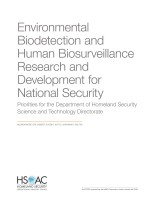| 来源类型 | Research Reports
|
| 规范类型 | 报告
|
| DOI | https://doi.org/10.7249/RR2398
|
| ISBN | 9781977400888
|
| 来源ID | RR-2398-DHS
|
| Environmental Biodetection and Human Biosurveillance Research and Development for National Security: Priorities for the Department of Homeland Security Science and Technology Directorate |
| Melinda Moore; Eric Landree; Alison K. Hottes; Shoshana R. Shelton
|
| 发表日期 | 2018
|
| 出版年 | 2018
|
| 页码 | 98
|
| 语种 | 英语
|
| 结论 |
DHS role and CBD R&D- DHS has a unique niche for environmental BD within the federal government.
- DHS S&T CBD R&D addresses environmental BD more than human BSV.
- S&T supports more CBD activities related to sample testing (test development) and system configuration, and less work related to sample collection and processing or CONOPS.
- Most S&T CBD R&D activities related to aims to serve both DHS and non-DHS customers.
- The HSOAC team developed logic models to depict the activities, outputs, and anticipated intermediate and long-term outcomes stemming from S&T R&D in the key thematic areas encompassed by S&T; BD themes include developing tests for environmental detection, evaluating technologies and system concepts, performing research on biothreats and attribution of bioattacks, and providing resources, expertise, and facilities; BSV themes include developing tests for detection in humans, creating software prototypes and tools to aggregate, analyze, and display information and provide decision support, evaluating technologies and system concepts and conducting feasibility assessments, and engaging the public.
Non-S&T R&D related to environmental biodetection and human biosurveillance- Illustrative inventories of non-S&T R&D (with 152 distinct activities related to environmental BD and 282 related to human BSV) included relatively little R&D activity related to system configuration or CONOPS compared with other taxonomy categories; about one-fifth of R&D activity — for both BD and BSV — addressed security concerns.
- Most of the non-S&T BD R&D in the inventories has been supported by the Department of Health and Human Services (HHS), Department of Defense, and the National Science Foundation (NSF); most BSV activity has been supported by HHS and NSF.
|
| 摘要 |
- Develop a DHS strategic plan for environmental BD and human BSV R&D that is consistent with DHS's role in national biodefense.
- Prioritize BD R&D over BSV R&D, given the department's unique federal government role in this area.
- Prioritize R&D addressing CONOPS, given the relative lack of R&D in this area by either S&T or other agencies and the shorter-term potential for real-world application.
- Actively monitor R&D (at all stages of maturity) supported by other agencies, and adapt relevant outputs to meet DHS needs — for example, addressing BD and BSV test development, BD aerosol applications.
- Prioritize midstage and later stage R&D to complement or balance the current predominantly early stage research.
|
| 主题 | Biological Weapons and Warfare
; Biosurveillance
; Bioterrorism
; Chemical Terrorism
; Chemical Weapons and Warfare
; Public Health Preparedness
|
| URL | https://www.rand.org/pubs/research_reports/RR2398.html
|
| 来源智库 | RAND Corporation (United States)
|
| 引用统计 |
|
| 资源类型 | 智库出版物
|
| 条目标识符 | http://119.78.100.153/handle/2XGU8XDN/108909
|
推荐引用方式
GB/T 7714 |
Melinda Moore,Eric Landree,Alison K. Hottes,et al. Environmental Biodetection and Human Biosurveillance Research and Development for National Security: Priorities for the Department of Homeland Security Science and Technology Directorate. 2018.
|
|
文件名:
|
x1543421503307.jpg
|
|
格式:
|
JPEG
|

|
文件名:
|
RAND_RR2398.pdf
|
|
格式:
|
Adobe PDF
|
除非特别说明,本系统中所有内容都受版权保护,并保留所有权利。